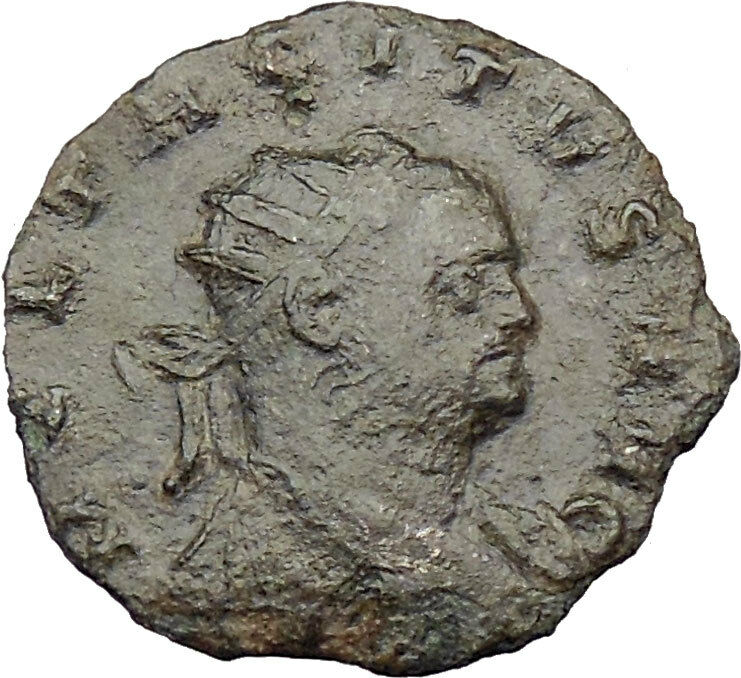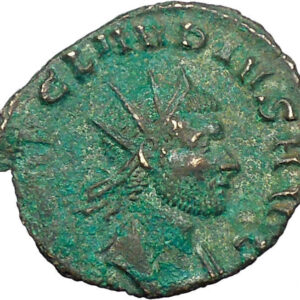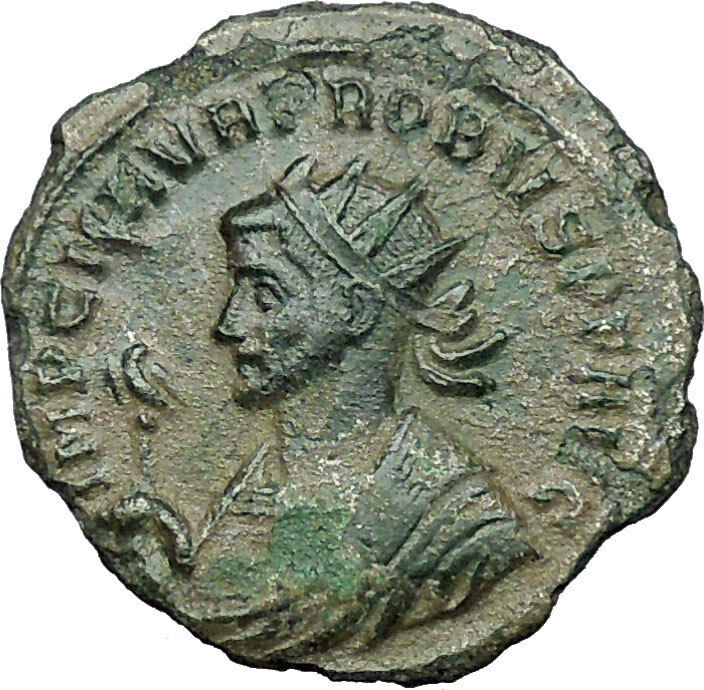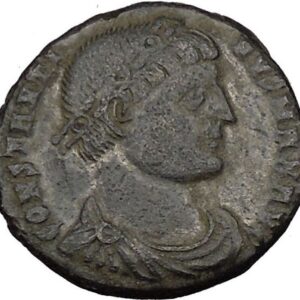|
Probus – Roman Emperor: 276-282
A.D. –
Bronze Antoninianus 21mm (2.55 grams) Struck at the mint
of Siscia 280 A.D.
Reference: RIC 660g
IMPCPROBVSPFAVG – Helmeted, radiate, cuirassed bust
left, holding spear over shoulder and shield.
R CONCORDIAAVG Exe: IIII/XXI – Concordia standing left,
holding patera and cornucopia.
You
are bidding on the exact item pictured, provided with a
Certificate of Authenticity and Lifetime Guarantee of
Authenticity.
The cornucopia (from Latin cornu copiae) or horn of plenty
is a symbol of abundance and nourishment, commonly a large horn-shaped container
overflowing with produce, flowers, nuts, other edibles, or wealth in some form.
Originating in
classical antiquity, it has continued as a
symbol in
Western art, and it is particularly associated
with the
Thanksgiving holiday in
North America.

Allegorical depiction of the Roman
goddess
Abundantia with a cornucopia, by
Rubens (ca. 1630)
In Mythology
Mythology offers multiple
explanations of the origin of the cornucopia.
One of the best-known involves the birth and nurturance of the infant
Zeus, who had to be hidden from his devouring father
Cronus. In a cave on
Mount Ida on the island of
Crete, baby Zeus was cared for and protected by
a number of divine attendants, including the goat
Amalthea (“Nourishing Goddess”), who fed him
with her milk. The suckling future king of the gods had unusual abilities and
strength, and in playing with his nursemaid accidentally broke off one of her
horns, which then had the divine power to
provide unending nourishment, as the foster mother had to the god.
In another myth, the cornucopia was created when
Heracles (Roman
Hercules) wrestled with the river god
Achelous and wrenched off one of his horns;
river gods were sometimes depicted as horned. This version is represented in the
Achelous and Hercules
mural painting by the
American Regionalist artist
Thomas Hart Benton.
The cornucopia became the attribute of several
Greek and
Roman deities, particularly those associated
with the harvest, prosperity, or spiritual abundance, such as personifications
of Earth (Gaia
or
Terra); the child
Plutus, god of riches and son of the grain
goddess
Demeter; the
nymph
Maia; and
Fortuna, the goddess of luck, who had the power
to grant prosperity. In
Roman Imperial cult, abstract Roman deities who
fostered peace (pax
Romana) and prosperity were also depicted with a cornucopia,
including
Abundantia, “Abundance” personified, and
Annona, goddess of the
grain supply to the city of Rome.
Pluto, the classical ruler of the underworld in
the
mystery religions, was a giver of agricultural,
mineral and spiritual wealth, and in art often holds a cornucopia to distinguish
him from the gloomier
Hades, who holds a
drinking horn instead.
Modern depictions
In modern depictions, the cornucopia is typically a hollow, horn-shaped
wicker basket filled with various kinds of festive
fruit and
vegetables. In North America, the cornucopia
has come to be associated with
Thanksgiving and the harvest. Cornucopia is
also the name of the annual November Wine and Food celebration in
Whistler, British Columbia, Canada. Two
cornucopias are seen in the
flag and
state seal of
Idaho. The Great
Seal of
North Carolina depicts Liberty standing and
Plenty holding a cornucopia. The coat of arms of
Colombia,
Panama,
Peru and
Venezuela, and the Coat of Arms of the State of
Victoria, Australia, also feature the
cornucopia, symbolising prosperity.
The horn of plenty is used on body art and at Halloween, as it is a symbol of
fertility, fortune and abundance.
-
Base of a statue of
Louis XV of France
Probus (Latin:
Marcus Aurelius Probus
Augustus; c. 19 August 232 –
September/October 282), was
Roman Emperor from 276
to 282.

During his reign, the
Rhine and
Danube frontier was
strengthened after successful wars against several
Germanic tribes such as
the
Goths,
Alamanni,
Longiones,
Franks,
Burgundians, and
Vandals. The
Agri Decumates and much
of the
Limes Germanicus in
Germania Superior were
officially abandoned during his reign, with the Romans
withdrawing to the
Rhine and
Danube rivers.
Life
Born in 232 in
Sirmium (modern day
Sremska Mitrovica),
Pannonia Inferior, the
son of Dalmatius, Probus entered the army around 250
upon reaching adulthood. Appointed as a
military tribune by the
emperor
Valerian, he later
distinguished himself under the emperors
Aurelian and
Tacitus. He was
appointed governor of the East by Tacitus, whose death
in 276 prompted Probus’ soldiers to proclaim him
emperor.
Florianus, the
half-brother of Tacitus, was also proclaimed successor
by his soldiers, but he was killed after an indecisive
campaign.[9]
Probus travelled west, defeating the Goths along the
lower Danube in 277, and acquiring the title of
Gothicus. His position as emperor was ratified by
the
Senate around this
time.
As Emperor
In 278, Probus campaigned successfully in
Gaul against the
Alamanni and
Longiones; both tribes
had advanced through the
Neckar valley and
across the Rhine into Roman territory. Meanwhile, his
generals defeated the
Franks and these
operations were directed to clearing
Gaul of Germanic
invaders (Franks
and
Burgundians), allowing
Probus to adopt the titles of Gothicus Maximus
and Germanicus Maximus.
One of his principles was never to allow the soldiers
to be idle, and to employ them in time of peace on
useful works, such as the planting of vineyards in Gaul,
Pannonia and other districts, in order to restart the
economy in these devastated lands.[14]
Of a greater and more lasting significance, Probus began
the strategy of settling the Germanic tribes in the
devastated provinces of the empire.

Antoninianus
of Probus minted in 280. Depicts the solar
divinity
Sol Invictus
riding a
quadriga.
Probus issued many different coins during
his six years of rule.
In 279-280, Probus was, according to
Zosimus, in
Raetia,
Illyricum and
Lycia, where he fought
the
Vandals. In the same
years, Probus’ generals defeated the
Blemmyes in
Egypt. Probus then
ordered the reconstruction of bridges and canals along
the Nile, where the production of grain for the Empire
was centered.
In 280-281, Probus put down three usurpers,
Julius Saturninus,
Proculus and
Bonosus. The extent of
these revolts is not clear, but there are clues that
they were not just local problems. In 281, the emperor
was in Rome, where he celebrated his
triumph.
Probus was eager to start his eastern campaign,
delayed by the revolts in the west. He left Rome in 282,
travelling first towards Sirmium, his birth city. About
Probus’ death different accounts exist. According to
John Zonaras, the
commander of the
Praetorian Guard
Marcus Aurelius Carus
had been proclaimed, more or less unwillingly, emperor
by his troops.
Assassination (282)
Probus sent some troops against the new usurper, but
when those troops changed sides and supported Carus,
Probus’ remaining soldiers assassinated him at Sirmium
(September/October 282). According to other sources,
however, Probus was killed by disgruntled soldiers, who
rebelled against his orders to be employed for civic
purposes, like draining marshes.[24]
Carus was proclaimed emperor after Probus’ death and
avenged the murder of his predecessor.
In
Roman religion, Concord (Latin:
Concordia, “harmony”) was the
goddess of agreement, understanding, and marital harmony. Her Greek version is
Harmonia, and the Harmonians and some
Discordians equate her with
Aneris. Her opposite is Discordia (or the Greek
Eris).The
cult of Concordia
Augusta (“Majestic Harmony”) was of special importance to the
imperial household. Dedicatory inscriptions to her, on behalf of emperors
and members of the imperial family, were common. The oldest
Temple of Concord, built in
367 BC by
Marcus Furius Camillus, stood on the
Roman
Forum. Other temples and shrines in Rome dedicated to Concordia were largely
geographically related to the main temple.
|












